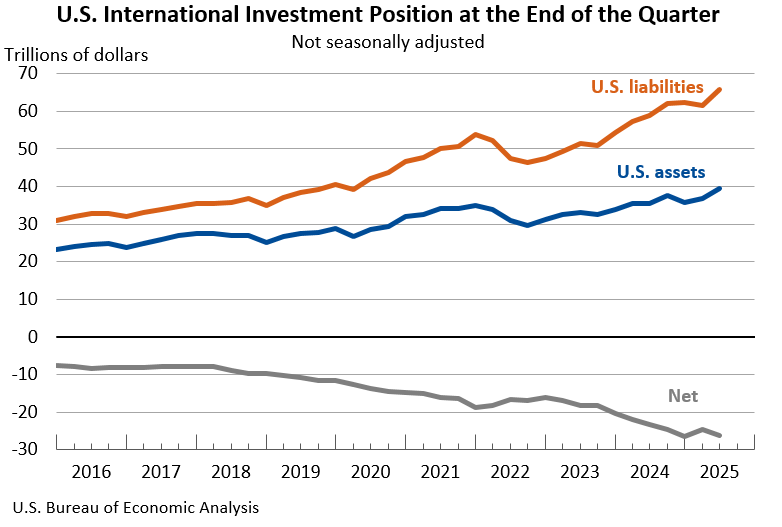Notice
Due to a lapse in appropriations, this website is not being updated.
Bureau of Economic Analysis
U.S. International Investment Position, 2nd Quarter 2025
The U.S. net international investment position, the difference between U.S. residents’ foreign financial assets and liabilities, was -$26.14 trillion at the end of the second quarter of 2025, according to statistics released today by the U.S. Bureau of Economic Analysis. Assets totaled $39.56 trillion, and liabilities were $65.71 trillion. At the end of the first quarter, the net investment position was -$24.65 trillion (revised).
Principal Federal Economic Indicators
Noteworthy
The Latest
November 2017 Trade Gap is $50.5 Billion
The U.S. monthly international trade deficit increased in November 2017 according to the U.S. Bureau of Economic Analysis and the U.S. Census Bureau. The deficit increased from $48.9 billion in October (revised) to $50.5 billion in November, as imports increased more than exports. The previously published October deficit was $48.7 billion. The goods deficit increased $1.7 billion in November to $70.9 billion. The services surplus increased $0…
U.S. Net International Investment Position Third Quarter 2017
The U.S. net international investment position increased to −$7,768.7 billion (preliminary) at the end of the third quarter from −$8,004.1 billion (revised) at the end of the second quarter. The $235.4 billion increase reflected net financial transactions of –$87.4 billion and net other changes in position, such as price and exchange-rate changes, of $322.8 billion.
U.S. International Investment Position, 3rd quarter 2017
The U.S. net international investment position increased to -$7,768.7 billion (preliminary) at the end of the third quarter of 2017 from -$8,004.1 billion (revised) at the end of the second quarter, according to statistics released by the Bureau of Economic Analysis (BEA). The $235.4 billion increase reflected a $1,001.2 billion increase in U.S. assets and a $765.8 billion increase in U.S. liabilities (table 1).
BEA Focuses on Data Users With Innovations in 2017, New Projects Ahead
As we charge into 2018, it’s a fitting time to remember innovations over the past year that advanced the Bureau of Economic Analysis’ quest to produce the most accurate, timely, and objective statistics that promote better understanding of the nation’s economy.
Real Consumer Spending Rises in November
Personal income increased 0.3 percent in November after increasing 0.4 percent in October. Wages and salaries, the largest component of personal income, increased 0.4 percent in November after increasing 0.2 percent in October.
Personal Income And Outlays, November 2017
Personal income increased $54.0 billion (0.3 percent) in November according to estimates released today by the Bureau of Economic Analysis. Disposable personal income (DPI) increased $50.9 billion (0.4 percent) and personal consumption expenditures (PCE) increased $87.1 billion (0.6 percent).
GDP Up in the Third Quarter
Real gross domestic product (GDP) increased 3.2 percent in the third quarter of 2017, according to the “third” estimate released by the Bureau of Economic Analysis. The growth rate was 0.1 percentage point less than the “second” estimate released in November. In the second quarter of 2017, real GDP increased 3.1 percent.
Gross Domestic Product, 3rd quarter 2017 (third estimate); Corporate Profits, 3rd quarter 2017 (revised estimate)
Real gross domestic product (GDP) increased at an annual rate of 3.2 percent in the third quarter of 2017 (table 1), according to the "third" estimate released by the Bureau of Economic Analysis. In the second quarter, real GDP increased 3.1 percent.
State Personal Income, Third Quarter 2017
State personal income increased 0.7 percent on average in the third quarter of 2017. In the second quarter, state personal income increased 0.6 percent. Increases in earnings and personal current transfer receipts were the leading contributors to the acceleration in personal income in the third quarter.
State Quarterly Personal Income, 3rd quarter 2017
State personal income increased 0.7 percent on average in the third quarter of 2017, according to estimates released today by the Bureau of Economic Analysis (table 1). In the second quarter, state personal income increased 0.6 percent. Increases in earnings and personal current transfer receipts were the leading contributors to the acceleration in personal income in the third quarter.




